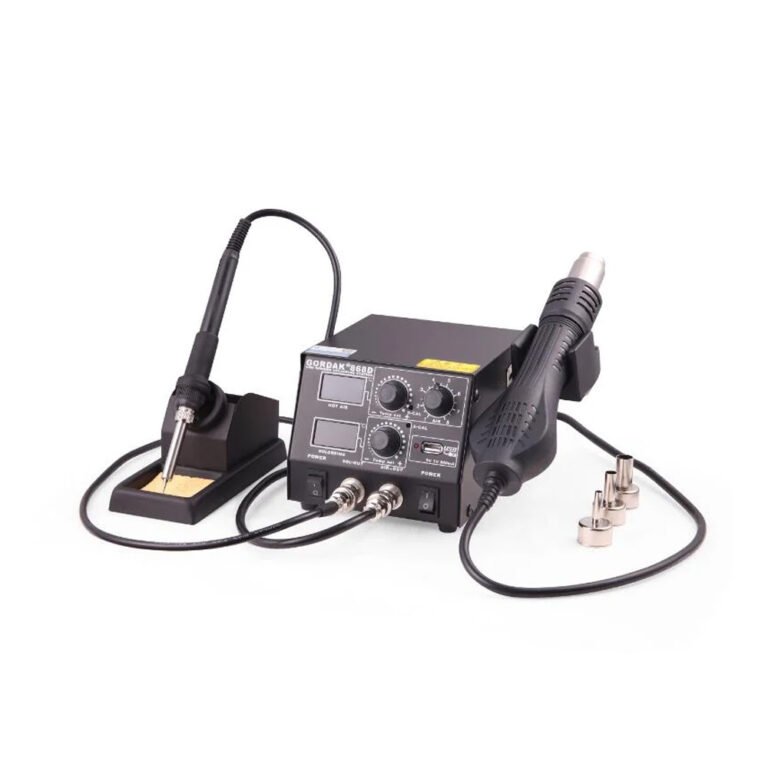When it comes to repairing modern electronics, precision and control are non-negotiable. BGA (Ball Grid Array) and SMD (Surface-Mount Device) components are widely used in today’s compact PCBs, and repairing them requires specialized tools and techniques. Hot air soldering is one of the most effective solutions for this task.
In this guide, Gordak outlines how hot air soldering supports accurate, safe, and effective rework of BGA and SMD components.
Why Use Hot Air Soldering for BGA and SMD Repair?
Unlike through-hole components, BGA and SMD parts do not have exposed leads. Traditional soldering irons cannot reach the hidden joints beneath BGA packages, and they risk damaging delicate SMDs. Hot air soldering offers a non-contact, evenly distributed heat source that can:
- Reflow solder joints under BGAs and small SMDs
- Prevent thermal shock to nearby components
- Allow precise removal and placement of components
Key Applications
Hot air soldering is ideal for repairing:
- BGA chips on computer motherboards and mobile phones
- Fine-pitch SMD ICs and connectors
- Passive SMD components (resistors, capacitors, etc.)
- Damaged pads or cold solder joints on dense PCBs
Essential Tools for the Job
To perform BGA and SMD repair efficiently, you’ll need:
- Hot Air Rework Station: Gordak stations offer adjustable airflow and temperature for precision work.
- Tweezers and Vacuum Pickup Tools: For safe handling of components.
- Solder Paste or Flux Pen: To assist in reflow and ensure good wetting.
- Preheater (optional but recommended): Helps reduce thermal stress on multilayer boards.
- Microscope or Magnifier: For inspecting solder joints before and after the process.
Step-by-Step: Hot Air Soldering for BGA Repair
1. Apply Flux
Apply high-quality no-clean flux beneath the BGA chip to aid solder flow and prevent oxidation.
2. Preheat the PCB
Gradually raise the temperature of the board using the preheater or rework station to minimize warping and thermal stress.
3. Remove the BGA
Heat the BGA area evenly using the hot air tool. Once the solder reflows, gently lift the chip using tweezers or a vacuum pickup.
4. Clean and Prepare Pads
Remove excess solder and clean the area with isopropyl alcohol. Apply fresh solder paste if needed.
5. Align and Place the BGA
Use a BGA alignment jig or visual markers to position the new or reballed chip accurately.
6. Reflow the BGA
Heat the area again with the hot air tool, following a recommended temperature profile. Let the solder balls reflow and form joints.
7. Cool and Inspect
Allow the board to cool gradually. Then inspect the solder joints using X-ray, if available, or check for shorts and opens with a multimeter.
Tips for SMD Component Rework
- Use lower airflow settings for lightweight components to avoid displacement
- Secure nearby components with kapton tape or shielding
- Practice on scrap boards to refine your technique
Why Choose Gordak Hot Air Rework Stations?
Gordak offers hot air soldering stations engineered for high precision, durability, and user-friendly operation. With customizable airflow and temperature settings, our stations make BGA and SMD rework reliable—even for complex multilayer boards.
Our professional tools are trusted by electronics repair technicians, educators, and manufacturing teams around the world.
Conclusion
Hot air soldering is the gold standard for repairing BGA and SMD components due to its ability to deliver precise, non-contact heat. With the right tools, skills, and safety practices, technicians can achieve professional-grade repairs even on the most compact and intricate PCBs.
For product inquiries, technical support, or to explore Gordak’s full range of hot air rework stations, please contact us at info@gordakelec.com.
Hot Air Rework Stations
What Is a Hot Air Rework Station and How Does It Work?
Applications of a Hot Air Rework Station: What Can Be Soldered?
Hot Air Soldering for BGA and SMD Repair
Hot Air Rework Station vs. Infrared Rework Station: Pros and Cons
Analog vs. Digital Hot Air Rework Stations: What’s the Difference?
Using a Hot Air Rework Station for Mobile Phone Repairs
Can You Use a Hot Air Rework Station for Heat Shrink Tubing?
Hot Air Reflow Soldering: What It Is and How It Works
Hot Air Rework Station Maintenance Guide
Troubleshooting Common Hot Air Soldering Issues
Tips to Prevent PCB Damage While Using a Hot Air Rework Station
Beginner’s Guide to Using a Hot Air Rework Station Safely
How to Desolder SMD Components Using a Hot Air Rework Station



